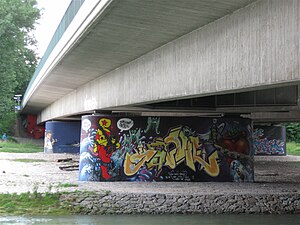Brudermühlbrücke
Coordinates: 48 ° 6 ′ 45 ″ N , 11 ° 33 ′ 36 ″ E
|
|
||
|---|---|---|
| Brudermühlbrücke | ||
| use | Pedestrian traffic , bicycle traffic , car traffic | |
| Convicted | Middle ring | |
| Crossing of | Isar | |
| place | Munich | |
| construction | Girder bridge | |
| overall length | 138 m | |
| width | 36 m | |
| Number of openings | 3 | |
| Longest span | 46.3 m | |
| Load capacity | 60 t | |
| construction time | 1904 reconstruction: 1953 |
|
| toll | toll-free | |
| location | ||
|
|
||
| Above sea level | 520 m above sea level NHN | |
The Brudermühlbrücke is a bridge in Munich . It is part of the Middle Ring .
location
The Brudermühlbrücke is located in the south of Munich and connects the two districts of Sendling and Untergiesing . It leads the Brudermühlstrasse over the Isar to Candidstrasse in the east . The west end of the bridge is on the Flaucher . In the extension of the Brudermühlbrücke, the Brudermühlstrasse crosses the Große Stadtbach via the Brudermühlsteg .
history
At the site of today's Brudermühlbrücke, a bridge over the Isar was built for the first time in 1904, when the old iron bridge was moved here when the Wittelsbacherbrücke was rebuilt as part of the Munich bridge-building program . The bridge and the road leading over it were named after the Brudermühle, one of the three mills on the Dreimühlenbach .
After this bridge was badly damaged in the Second World War in 1943 , a temporary pedestrian walkway was built over the destroyed areas in 1948.
The bridge was rebuilt by Dywidag in 1953 as part of the construction of a southern bypass for the Mittlerer Ring . The pillars and abutments of the old bridge could be reused, which significantly reduced the cost of construction. By using prestressed concrete for the first time on a Munich bridge, it was also possible to keep the cost of materials low and still achieve a load-bearing capacity of 60 tons. In 1969 the bridge was widened by an extension on the north side, and in 1988 by a further extension on the south side.
description
The Brudermühlbrücke is a girder bridge made of prestressed concrete that rests on two pillars. It has a total length of 138 meters and spans of 45.97, 45.97 and 46.30 meters. The width of the bridge is about 36 meters.
Brudermühlstrasse crosses the bridge with seven lanes: four to the east and three to the west.
The concrete pillars of the bridge have been sprayed with graffiti once or twice a year by young artists ( Hall of Fame ) since 1996 as part of the “isart” project of the Munich City District Youth Association .
literature
- Christine Rädlinger : History of the Munich bridges . Ed .: City of Munich, Construction Department. Verlag Franz Schiermeier, Munich 2008, ISBN 978-3-9811425-2-5 .
Web links
- Technical information about the Brudermühlbrücke. In: Structurae
- Brudermühlbrücke 08. In: The dye works. Kreisjugendring München-Stadt, accessed on March 31, 2010 .


